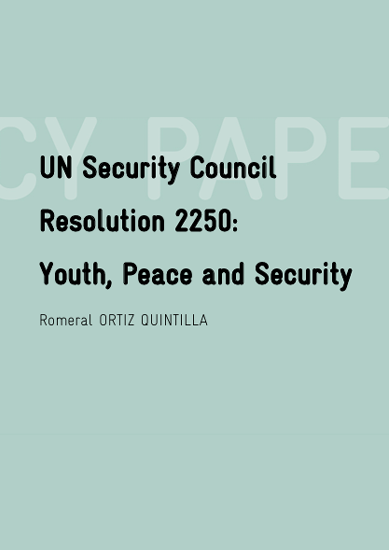The demographic argument is probably one of the most powerful and compelling reasons for recognising the role of youth in building peace: if the failure of peace processes has generally been associated with the absence or the limited inclusion of certain social groups, it was impossible to ignore a group that represents more than half of the population in fragile countries. But it is not only a matter of the role of youth in contexts of war or armed conflict, it is also a question of giving space and recognition to youth in their efforts to prevent all forms of violence (direct, cultural and structural) and in conflict transformation. Eventually, on 9 December 2015, the United Nations Security Council unanimously adopted a historic resolution on youth, peace and security, resolution 2250.
Background
Resolution 2250 is historic because it finally puts youth2 at the centre of processes and policies for the sustainable development of peace and security. It is a unique and unprecedented resolution for different reasons. To start with, it is the first time that the Security Council has adopted a thematic resolution dealing comprehensively with youth in issues related to peace and security. In addition, the document recognises the role of young people in their ability to promote peace, transform conflicts and prevent violence. In this resolution, youth are not considered only as a group to be protected (youth as victims), nor as a group to be protected from (youth as perpetrators of violence), but are rather considered as actors for positive change in their communities, recognizing their role as catalysts for peace and actors in preventing violence.
The resolution demands to give voice to young people in peace processes, urging governments, private institutions —including UN agencies— to provide both the tools and the necessary funding to transform the text into real policies and specific projects. Previously, the UN Security Council had always addressed this issue through resolutions focused on individual countries or regions. For example, resolutions 1702 and 2070 included within the mandate of the United Nations Stabilisation Mission in Haiti (MINUSTAH) the task of coordinating with the national government in order to provide employment opportunities for young people at risk of social exclusion, as well as the continuity of disarmament, demobilisation and reintegration programs to reduce violence in communities. Similarly, Security Council resolutions dealing with peacekeeping in Côte d’Ivoire, Sierra Leone, East Timor, Burundi, South Sudan and Yemen also included sections dedicated to youth. Resolution 2250 on youth, peace and security adopted on 9 December marked a shift in focus concerning young people and their participation in the field of peace.


